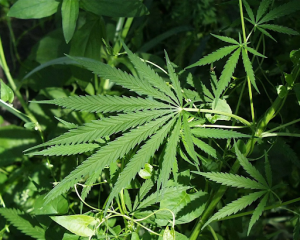Hemp V.S Wood, Which is Better For the Environment?
Written By: Tianna
Edited By: Morgan Pankarican
Designed By: Tvisha Lakhani
Published By: Linda Qi
People have been using wood for around 10,000 years. It has been a staple in every aspect of human life and we still use it in almost everything to this day. The concern is, is the use of wood good for the environment?

As we all know, trees provide our oxygen. As more trees get cut down, more carbon dioxide stays in the atmosphere, causing detrimental effects to our earth such as a warmer climate and more acidic oceans.
This brings the question of, what would we use other than wood?
The solution? Hemp.
Hemp Pros & Cons
Hemp is a plant a part of the Cannabacae family. Its main property is its fibres, which can be used to make a lot of things. Hemp is often used for cordage (twine, strings, etc), canvas, and can even be used to make shoes! Hemp can also be used to make paper and it is a more sustainable substance to make fibreglass with.
Hemp is also extremely nutritious, it is high in protein, fibre, and magnesium! Often sold as hemp hearts, they can be used in numerous dishes or even eaten raw!
As for the environmental aspects of hemp, it only takes 100 days to grow and can reach up to 20 feet when it’s ready for harvest. On one acre of land, 10 tons of hemp can be grown in only 100 days, allowing for rapid growth and use (without the use of harmful herbicides and pesticides either). Hemp is also incredibly high in cellulose, which helps in the process of photosynthesis, removing high amounts of carbon from the atmosphere.
The cons to using hemp is that if it’s being used for fabric it can be expensive as it requires extra care. In the case of negative environmental impacts, hemp doesn’t have any.
Wood Pros & Cons
Wood is a staple material in everyone’s life, and it can be used for SO many things. Does this mean it’s the best material to use though?
Wood is great because it uses less fossil fuels than things such as aluminium, steel, or concrete. Wood is a natural insulator for housing. And wood is a very versatile material as it is used for things such as tools, paper, furniture, fuel, building, and much more!
Sadly, with the use of wood comes a lot of negative impacts to the environment. There is the concern of deforestation, which limits habitats for animals and can remove important carbon sinks around the world. Wood can take up to 100 years to get to the growth point that hemp reaches in only 100 days. There is also the concern of the energy used in order to harvest wood. There is the time it takes to harvest it, and also the tools needed to access the wood.
What’s the verdict?
While both have their pros, hemp is the material with the least negative environmental impacts. Hemp would be the best material to use in replacement of wood, or to even lessen the amount of wood harvested. This would allow forests to regrow, provide animals with their homes and aid in decreasing the carbon in the atmosphere.
Although hemp may not be able to take over the use of wood right away, keeping an eye out for and using hemp based products rather than wood will greatly help the environment which will hopefully encourage major corporations to start making that switch!
References
D’Costa, Krystal. “A Story of Wood – Scientific American Blog Network.” Scientific American Blogs, 4 June 2015, https://blogs.scientificamerican.com/anthropology-in-practice/a-story-of-wood/. Accessed 22 September 2022.
“5 Ways Hemp Can Save the Planet.” Rodale Institute, 13 November 2019, https://rodaleinstitute.org/blog/5-ways-hemp-can-save-the-planet/. Accessed 22 September 2022.
“hemp | Description, Products, Seeds, Fiber, & Uses.” Britannica, 31 August 2022, https://www.britannica.com/plant/hemp. Accessed 22 September 2022.
Higgins, Jenny. “Forest Industries and the Environment.” Newfoundland and Labrador Heritage, https://www.heritage.nf.ca/articles/economy/forestry-environment.php. Accessed 22 September 2022.
Lynch, Patrick. “What Are the Pros and Cons of Hemp as a Material?” WayofLeaf, 11 November 2020, https://wayofleaf.com/hemp/pros-and-cons-of-hemp-as-a-material. Accessed 22 September 2022.
Norén, Anders. “Hemp Can Save Trees – Are We Consuming Pulpwood ?” KPU WordPress, https://wordpress.kpu.ca/najikad93/hemp-can-save-trees/. Accessed 22 September 2022.
“The Real Pros and Cons of Hemp.” What is Hemp, https://whatishemp.com/hemp-pros-and-cons/. Accessed 22 September 2022.
Simmon, Robert. “The Carbon Cycle.” The Carbon Cycle, 16 June 2011, https://earthobservatory.nasa.gov/features/CarbonCycle/page5.php. Accessed 22 September 2022.
Wang, Ying, et al. “The Environmental Consequences Concerning the Use of Timber in the Built Environment.” Frontiers, 10 October 2019, https://www.frontiersin.org/articles/10.3389/fbuil.2019.00129/full. Accessed 22 September 2022.
Woods, Sarah. “A History of Wood from the Stone Age to the 21st Century.” Architect Magazine, https://www.architectmagazine.com/technology/products/a-history-of-wood-from-the-stone-age-to-the-21st-century_o. Accessed 22 September 2022.

